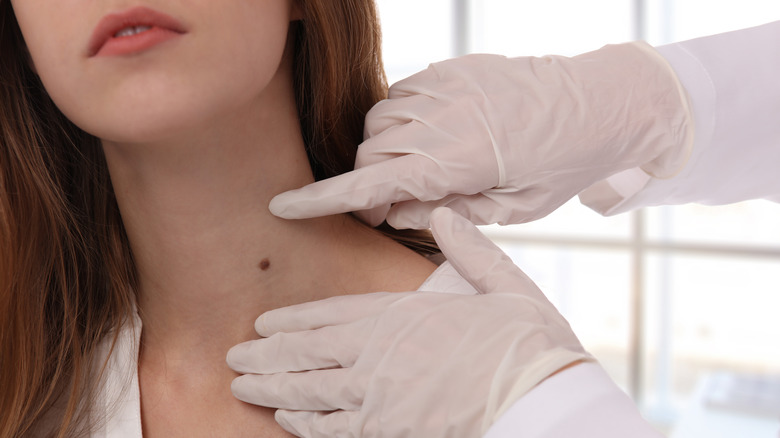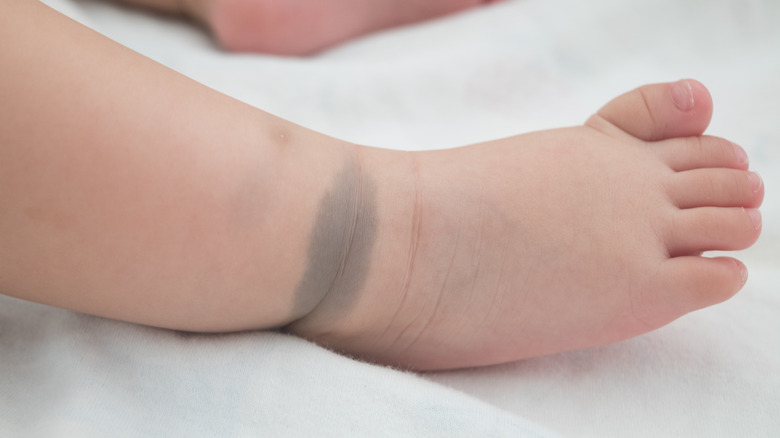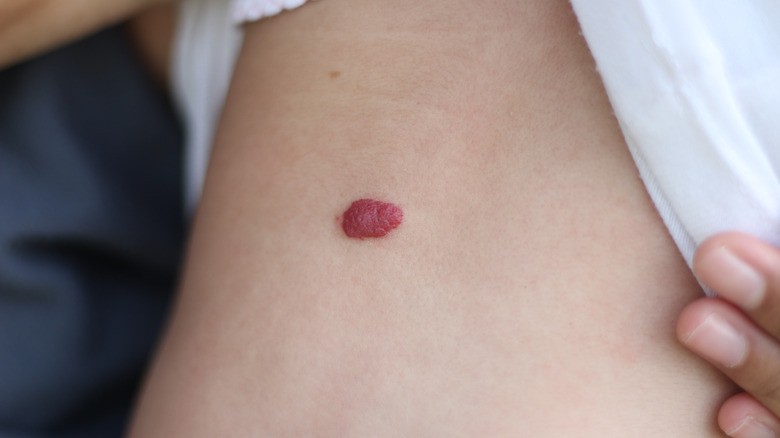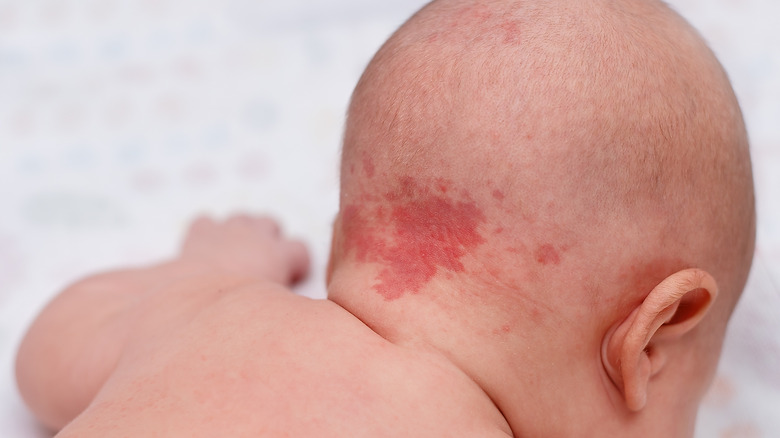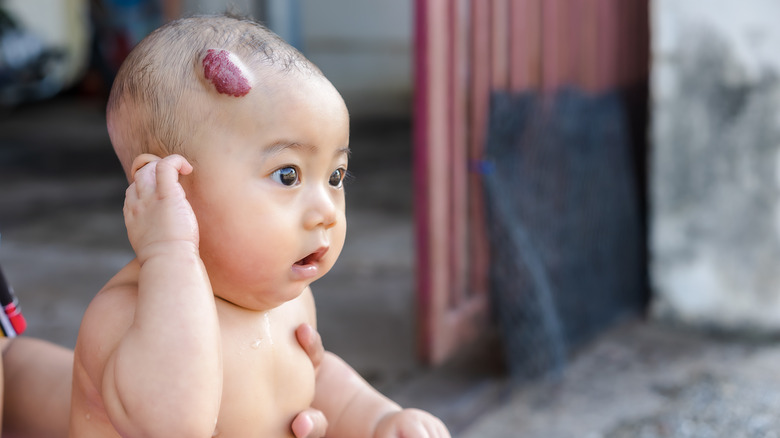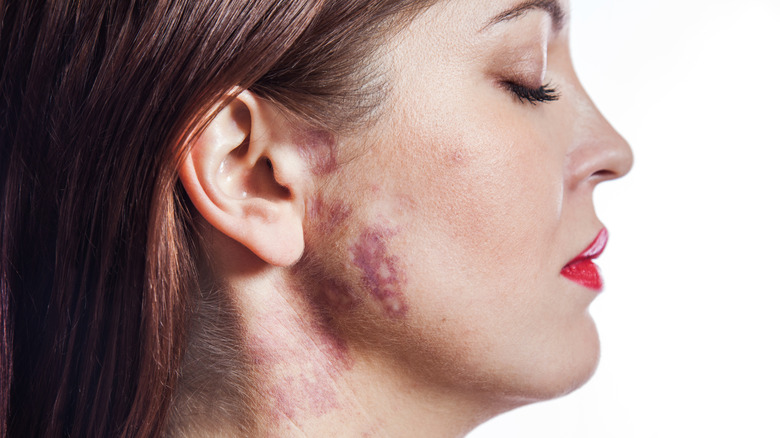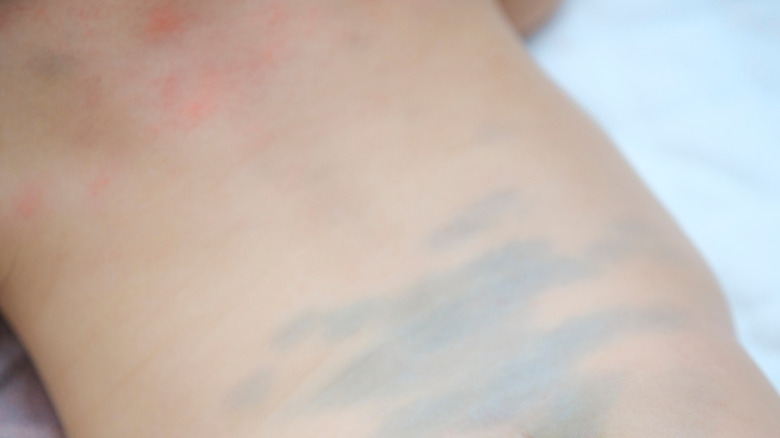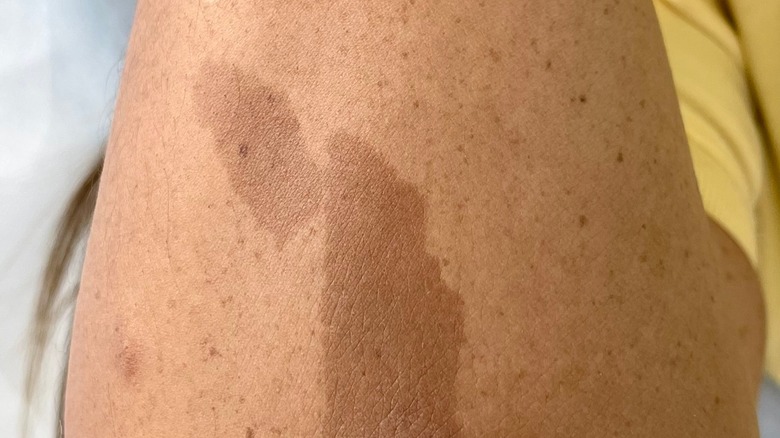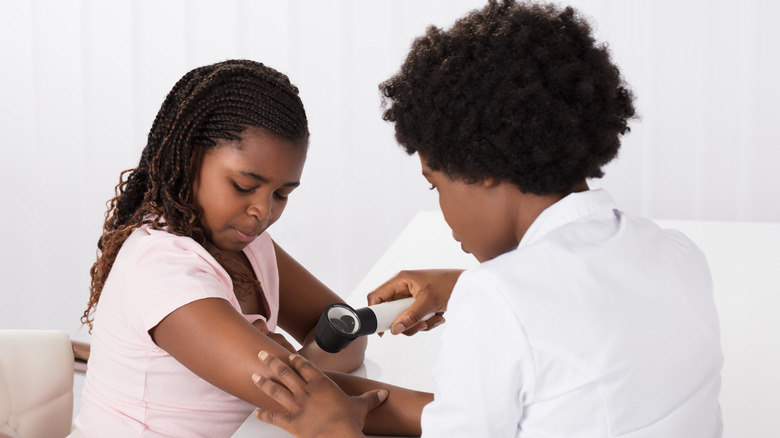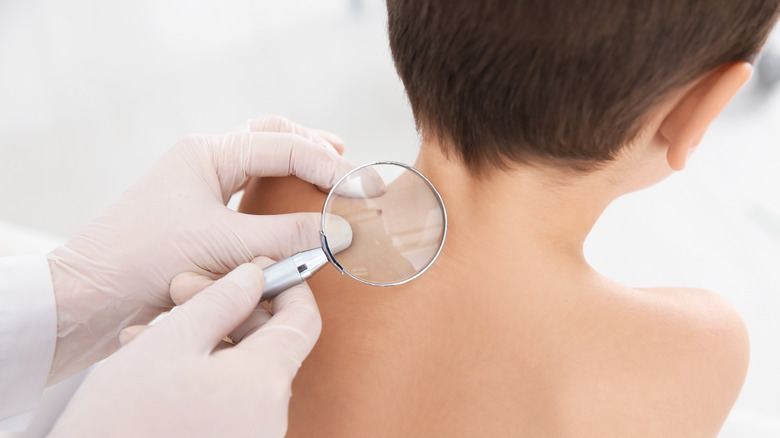Types Of Birthmarks And When You Should Worry
As a parent, it's natural to worry when you notice a mark on your baby's skin. That said, birthmarks are very common, and most kids are born with some kind of birthmark. These marks are typically harmless, but they can sometimes be signs of illnesses or other health conditions. It's important to be aware of the different types of birthmarks, though, in case you need to speak to a doctor about it.
Want to learn more about various kinds of birthmarks and when to consult a physician about them? You might want to know if you should be worried about your baby's birthmark, or you might just want to learn how to identify your child's birthmark. Here is everything you should know about birthmarks, including what they are, what causes them, the various types, how to treat them, and when you should begin to worry about that birthmark visible on the skin of your own little bundle of joy.
What are birthmarks?
Birthmarks are common spots that develop on babies' skin either before or shortly after birth. You might think from their name that birthmarks always show up when a baby is born, but hemangiomas and some other marks actually present weeks after birth. Most of these birthmarks permanently remain on the skin for your child's entire life, but some kinds of marks do fade away as your kid grows up.
Most babies have some type of birthmark when they are born, and they are typically harmless. However, for some kinds of birthmarks, your baby will need treatment either due to fast growth or for cosmetic purposes. Other marks might be symptoms of underlying illnesses or health conditions. Birthmarks can have either irregular or regular borders, appear raised or flat, and appear in various shades, including purple, red, pink, blue, black, tan, or brown.
Physicians don't know the cause of most marks. Some types of birthmarks can run in families, but doctors have not found a genetic cause, and most marks are not connected to skin trauma during childbirth. Birthmarks also are not caused by anything that happens during pregnancy, and they cannot be prevented in any way.
Types of birthmarks
Birthmarks can be categorized into two primary types: vascular birthmarks and pigmented birthmarks. These two types of birthmarks have different causes. Vascular birthmarks occur when the blood vessels don't properly form, while pigmented birthmarks show up when too many skin pigmentation cells grow in one spot.
Vascular birthmarks are typically red but can either be flat or raised. Some kinds of vascular birthmarks appear when the baby is born, while other types show up over the first couple of weeks of your child's life. Some vascular birthmarks grow over time to cover big swaths of skin. The primary types of vascular birthmarks are port-wine stains, hemangiomas, and macular stains.
Pigmented birthmarks show up on the skin when there are too many pigment cells, also known as melanocytes, in one region of your child's skin. These skin pigmentation cells give your baby their natural skin color, so when too many pigment cells gather in one place, it appears as a birthmark. The main kinds of pigmented birthmarks are Mongolian spots, cafe-au-lait spots, and moles, also known as congenital nevi.
Vascular birthmarks
Also known as angel's kisses or stork's bites colloquially and as vascular anomalies according to the official medical terminology, vascular birthmarks are irregular blood vessels that usually appear as reddened skin which can range in color from pink to red to blue to brown. You will typically see vascular birthmarks on your child's skin pretty soon after birth, but they can also be discovered later in life since they sometimes grow deep under the skin.
Vascular birthmarks are both harmless and painless and usually don't lead to any symptoms aside from the discoloration of the skin. Vascular anomalies consist of two primary categories: vascular malformations and vascular tumors. Vascular malformations are a group of irregularly connected blood vessels and include port-wine stains and macular stains, while vascular tumors include hemangiomas.
Vascular birthmarks have no known risk factors or causes. Treatment options include radiology, surgery, laser therapy, and steroid treatment.
Macular stains
Also known as salmon patches or nevus simplex, macular stains consist of red or pink marks that can show up anywhere on a baby's body. These simple vascular malformations can include angel's kisses or stork's bites.
Angel's kisses are marks that appear on the eyelids, upper lip, nose, or forehead, while stork's bites show up as reddened skin on the back of your baby's neck. Macular stains can also show up on the back of your child's head. They may slowly disappear as your child gets older and can appear more visible while your little one is crying.
Macular stains are the most common vascular anomalies and tend to fade away gradually by your baby's first or second birthday, though some can remain on your child's skin well into adulthood. They usually don't need any treatment, but you can opt to treat them with laser therapy if they don't disappear over time.
Hemangiomas
Also known as a strawberry mark, a hemangioma is a non-cancerous, or benign growth, composed of extra blood vessels in a baby's skin. No one knows precisely what causes hemangiomas. While you might have some other family members with hemangiomas, they are not caused by genetics. This type of birthmark is more prevalent among girls than boys and is more frequently seen in children, twins, and premature infants of Caucasian descent.
Hemangiomas typically go through multiple growth phases before disappearing on their own. Most of these birthmarks show up during the first couple of weeks of your baby's life and grow rapidly for the first few months. After this period, the birthmark usually slows down and grows more steadily for the next four months or so. After this period of gradual growth is a period of approximately six months when the hemangioma does not grow at all.
When your baby is about 12 months old, the hemangioma starts to fade away and shrink. This shrinking and fading process can take anywhere from approximately one year to one decade, and most hemangiomas entirely disappear during this period. After it's gone, your child might be left with wrinkly, soft skin or superficial blood vessels in the area of the former hemangioma. Laser treatments and surgery are potential treatment options for these skin changes when your child is older.
Port-wine stains
True to its name, a port-wine stain resembles dark red wine splashed or spilled across the skin. The birthmark typically appears pink in color when your baby is born, but it changes to a dark red, maroon, or reddish-purple color as your child grows. Unfortunately, port-wine stains cannot be prevented in any way and don't disappear on their own, but you can treat them with laser therapy. This is an excellent option for fading the birthmark and shrinking the blood vessels to make the mark less visible.
Also known as a nevus flammeus, a port-wine stain can show up anywhere on your baby's body, but it will typically appear on the legs, arms, scalp, neck, or face. The birthmark comes in all different sizes and typically grows with your baby. The texture will also evolve over time. Port-wine stains are usually flat and smooth at birth, but they can feel thick and rough to the touch by the time your child reaches adulthood.
Pigmented birthmarks
Pigmented birthmarks appear as raised or flat spots with irregular or regular borders on the skin in colors ranging from blue to black to brown. This kind of birthmark, which is caused by too many skin pigmentation cells growing in one place, typically appears either at birth or soon after birth.
Most pigmented birthmarks do not cause any medical issues, but you should get any larger, irregular, or fast-changing birthmarks checked out for potential early symptoms of skin cancer. You and your child can visit a pediatric dermatologist who can diagnose the birthmark and search for any worrying symptoms. Pigmented birthmarks can be treated with melanoma screenings or surgical removal.
Even if the birthmark is completely harmless, you can have it removed if it bothers you or your baby. If the mark is not removed, make sure that you or your child monitor it over the course of their life. The main kinds of pigmented birthmarks are Mongolian spots, moles, and cafe-au-lait spots, to be discussed in more detail.
Mongolian spots
Also known as Mongolian blue spots or dermal melanocytosis, Mongolian spots are flat blue-gray or blue birthmarks that show up either at birth or during the first couple of weeks of a baby's life. These spots appear at the bottom of the spine, either on the back or the buttocks but can also pop up on your child's shoulders. Fortunately, Mongolian spots are completely benign and harmless and are not connected to any diseases or health conditions.
Mongolian spots are most common amongst those of African, East Indian, Hispanic, Native American, or Asian descent. The birthmark's color comes from a group of melanocytes or skin pigmentation cells in the skin's deepest layers. The birthmarks can cover a big swath of the back and are typically between 2 and 8 centimeters wide or even bigger. They are also generally flat with an abnormal shape and unclear edges, with no particular texture.
Keep in mind that Mongolian spots are sometimes confused as bruises because of their color and appearance, but they are definitely birthmarks. Normal spots typically fade within the first few years and disappear completely by the time your child is a teenager. Treatment is usually only recommended for Mongolian spots when they are a symptom of an underlying condition.
Moles
The most common kind of pigmented birthmark, moles, not to be confused with skin tags, are skin growths ranging from black to brown to your baby's natural skin tone. Also known as a beauty mark or congenital nevus, moles are usually harmless and can last for up to 50 years. They are not contagious and do not typically bleed, itch, or hurt.
Moles come in a variety of types, including include dysplastic nevi, congenital nevi, and common nevi. They can show up anywhere on your mucous membranes or skin either in groups or alone. Most appear sometime during the first couple decades of your child's life, and it's common to have 10 to 40 of these spots by adulthood. Moles typically evolve slowly and become raised and lighter in color. Hairs sometimes grow within. Some moles, however, don't change in color or shape and gradually fade over time.
Common nevi are normal moles with distinct edges that are brown, tan, or pink in color, while congenital nevi appear on skin at birth and are likelier to evolve into melanoma than nevi that show up after birth. Congenital nevi are more likely to turn cancerous if they are over 8 millimeters in diameter. Dysplastic nevi are irregularly shaped and bigger than pencil erasers, typically with uneven, light edges and dark brown centers. If your child has dysplastic nevi, a dermatologist should monitor it for any changes, including skin cancer, as these moles are more likely to develop into malignant melanoma.
Cafe-au-lait spots
Cafe-au-lait spots are brown-pigmented birthmarks that appear on a baby's skin. These patchy spots can range in color from light to dark brown. The French phrase "cafe-au-lait" translates to "coffee with milk" in English, and the creamy color of this type of birthmark is typically similar to that of a cup of coffee blended with milk.
Cafe-au-lait spots vary in size from just 2 millimeters to over 8 inches in diameter. They can appear at birth, during early childhood, or even in adulthood. The spots themselves can evolve in number and size over the years. If your child has seven or more cafe-au-lait spots, this is a symptom of a genetic health condition called neurofibromatosis type 1, also known as NF1. The type of Cafe-au-lait spot is based on its pattern and shape and includes coast of California spots and coast of Maine spots, named for being shaped similar to these states.
The most common kind of cafe-au-lait spot is the coast of California spot, which has smooth and clear borders on each side, much like the coast of the state of California. You can either have one coast of California spot or multiple. If you do notice multiple spots, make sure to consult with a doctor. On the flip side, the coast of Maine spot is much less common and shows up as a spot with a jagged and rough border, similar to the coast of Maine.
How are birthmarks treated?
A few treatment methods for birthmarks exist depending on the type, but the most common treatment options include laser therapy, medication, and surgery. Your doctor or dermatologist might simply recommend carefully monitoring the birthmark for changes to treat it only if needed. This is typically the best approach for strawberry hemangiomas, which can grow quickly. Laser therapy is another excellent treatment option which works well for port-wine stains that don't disappear over time.
Several medications are available to treat birthmarks, including propranolol, timolol, corticosteroid, and interferon. Propranolol effectively shrinks hemangiomas or prevents them from growing. Timolol can also help shrink growing hemangiomas and treat babies with glaucoma. You can apply this liquid medication to your baby's birthmark. Corticosteroid medication can also shrink hemangiomas and is typically prescribed as a pill or injection. If your baby has a life-threatening mark, you can try interferon, a daily shot medication, though you'll need to learn how to deliver the shots and carefully watch your child for potential side effects.
Another common treatment for birthmarks, surgical removal is typically suggested for marks that could turn cancerous, such as moles. Surgical removal is usually not recommended until puberty. This treatment option is beneficial for treating larger, raised marks that impact your child's appearance and don't disappear on their own. Makeup is another common technique for adults and older kids to cover discolored skin from various birthmarks. Ask your dermatologist for a suggestion if you have difficulty finding the right makeup.
When to worry about a birthmark
Most birthmarks are harmless, but issues can sometimes crop up with port-wine stains, hemangiomas, moles, and Mongolian spots. If your baby develops any large port-wine stains on their face, they could experience seizures, developmental delays, or eye complications later in life, though the worst obstacle is typically embarrassment for your child as they get older. Most parents opt to have the birthmark surgically removed when your child is still little.
The worst kind of vascular birthmark, hemangiomas are fast-growing, small, red patches or bumps. These birthmarks usually fade or shrink by the time your child reaches elementary school, but they can cause issues if they are close to the eyes or if they begin to bleed. Definitely have a dermatologist check out any hemangiomas found near the chin, neck, or mouth since they could affect the vocal cords.
Mongolian spots are not medically harmful, but they can sometimes be mistaken for bruises, which can lead providers to incorrectly believe child abuse is taking place. These concerns go away once the Mongolian spots are properly diagnosed, and Mongolian spots themselves don't cause any physical harm to your child. Moles should be monitored in case they change in appearance or size, and any moles that could potentially turn into melanoma must be surgically removed. If your child has at least seven cafe-au-lait spots, visit a dermatologist to check for neurofibromatosis-1, a medical condition connected to irregular nerve tissue growth.
